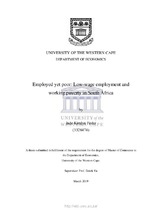| dc.description.abstract | Whilst paid employment has generally been considered as the predominant means of avoiding
poor living standards, the past two decades has seen a rise in the complex phenomenon of
employed poverty worldwide (Eardley, 1998; Nolan and Marx, 1999; Nolan et al., 2010;
Cheung and Chou, 2015). Over time, low-wage employment has increased in both number and
severity, resulting in or contributing significantly to household poverty (Nolan and Marx,
1999). While individuals are employed in paid work, salaries are too low for households to
maintain “a reasonable standard of living” (Cheung and Chou, 2015 p. 318).
Internationally, employed poverty has been a serious and well-researched problem in the
United States of America (USA or US). More than 11% of the USA “population resided in
poor households with at least one employed person” (Brady et al., 2010 p. 560). In Hong Kong,
approximately 53.5% of the population living in poverty were working poor in 2012
(Government of the Hong Kong Special Administrative Region, 2013). Closer to home, Sub-
Saharan Africa’s working poor rate for 2016 was estimated at 33.1% for workers earning less
than US $1.90 per day and 30% for those earning between US $1.90 and $3.10 per day
(International Labour Organisation, 2016). | en_US |

